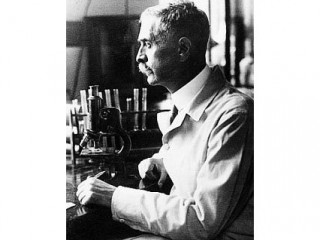
Karl Landsteiner biography
Date of birth : 1868-06-14
Date of death : 1943-06-26
Birthplace : Vienna, Austria
Nationality : Austrian-American
Category : Science and Technology
Last modified : 2011-08-30
Credited as : Immunologist, M and N agglutinogens,
Karl Landsteiner, the Austrian-born American immunologist and Nobel Prize winner, discovered blood groups and helped establish the science of immunochemistry.
Karl Landsteiner was born in Vienna on June 14, 1868. In 1891 he was awarded a medical degree by the University of Vienna. For the following 5 years he studied physiological chemistry in laboratories in Germany and Switzerland. In 1898 he moved to the Pathological Anatomical Institute in Vienna, where he carried on work that led to the discovery of blood groups.
It was known that blood transfusion often resulted in dangerous or fatal clumping of the red blood corpuscles. After a series of tests performed in his laboratory, Landsteiner postulated the existence in the corpuscles of agglutinogens (antigens) called A and B and in blood serum of agglutinins (antibodies) called anti-a and anti-b. Reaction to transfused blood (clumping) depended on whether the agglutinogens A, or B, or A and B, or neither were present in the red blood corpuscles. Where the agglutinogen A was present, serum containing the agglutinin anti-a could not be used, and so forth. Landsteiner's discovery was first announced in a footnote to a paper appearing in 1900. In 1909 he devised the familiar classification scheme for blood groups: A, B, AB, O. In 1930 he received the Nobel Prize for his discovery.
In 1906 Landsteiner and Victor Mucha introduced the use of the dark-field method of diagnosis for the presence of the spirochete of syphilis. In 1908 Landsteiner reported the transmittal of poliomyelitis to monkeys from human material, thus substantiating the theory that the cause of the disease was a virus. In 1919 he went from his work as professor of pathologic anatomy at the University of Vienna to The Hague in the Netherlands as pathologist at the R. K. Ziekenhuis. In 1922 he went to New York City's Rockefeller Institute. He became a citizen of the United States and continued at the institute until his death.
In 1927 Landsteiner and Philip Levine announced the discovery of the M and N agglutinogens, and in 1940 Landsteiner and a colleague discovered still another group of agglutinogens called the Rh factors. Both discoveries were announced in the Proceedings of the Society for Experimental Biology. Of fundamental importance to the rise of immunochemistry was Landsteiner's demonstration that serological specificity is based on the chemical structure of antigens. His findings were summarized in Specificity of Serological Reactions (1936). Landsteiner continued to work until 2 days before his death on June 26, 1943.
















